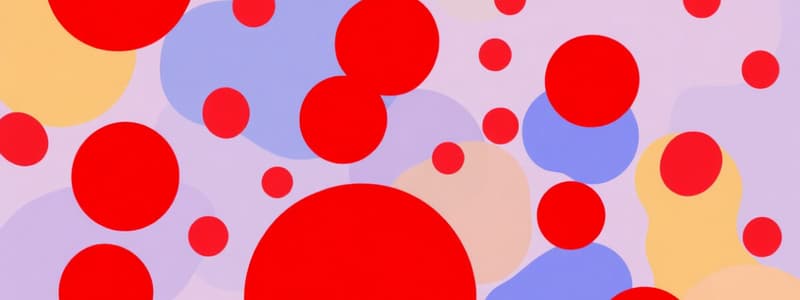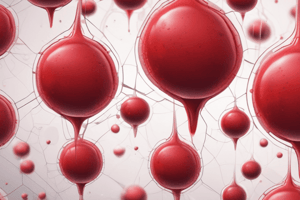Podcast
Questions and Answers
What is the lifespan of an erythrocyte?
What is the lifespan of an erythrocyte?
- 200-220 days
- 150-180 days
- 50-60 days
- 100-120 days (correct)
Which blood group is considered the universal donor?
Which blood group is considered the universal donor?
- Blood group A
- Blood group B
- Blood group AB
- Blood group O (correct)
What will happen when a subject with blood group A receives blood from a donor with blood group B?
What will happen when a subject with blood group A receives blood from a donor with blood group B?
- Transfusion will be successful
- The recipient will develop new antibodies
- A hemolytic reaction will occur (correct)
- No reaction will occur
What determines the presence or absence of blood group antigens A and B?
What determines the presence or absence of blood group antigens A and B?
In the context of Rh blood typing, what indicates a positive Rh factor?
In the context of Rh blood typing, what indicates a positive Rh factor?
What risk does an Rh- mother face if sensitized during her first pregnancy with an Rh+ child?
What risk does an Rh- mother face if sensitized during her first pregnancy with an Rh+ child?
What are the specific antibodies associated with blood group A?
What are the specific antibodies associated with blood group A?
What is the primary function of erythrocytes in the blood?
What is the primary function of erythrocytes in the blood?
Which component of blood constitutes the majority of its volume?
Which component of blood constitutes the majority of its volume?
What triggers the formation of red blood cells (erythropoiesis)?
What triggers the formation of red blood cells (erythropoiesis)?
Which of the following statements about leukocytes is true?
Which of the following statements about leukocytes is true?
What is the average blood volume in adult females?
What is the average blood volume in adult females?
What is the role of platelets in the blood?
What is the role of platelets in the blood?
What is the normal pH range of blood?
What is the normal pH range of blood?
What is the process of forming white blood cells called?
What is the process of forming white blood cells called?
Flashcards
Blood
Blood
The fluid connective tissue that circulates throughout the body, transporting oxygen, nutrients, and waste products.
Blood Plasma
Blood Plasma
The liquid component of blood, composed of water, proteins, and other solutes.
Formed Elements
Formed Elements
The cellular components of blood, including red blood cells (RBCs), white blood cells (WBCs), and platelets.
Erythrocytes
Erythrocytes
Signup and view all the flashcards
Leukocytes
Leukocytes
Signup and view all the flashcards
Platelets
Platelets
Signup and view all the flashcards
Hematopoiesis
Hematopoiesis
Signup and view all the flashcards
Leucopoiesis
Leucopoiesis
Signup and view all the flashcards
What are blood groups?
What are blood groups?
Signup and view all the flashcards
What are the ABO blood groups?
What are the ABO blood groups?
Signup and view all the flashcards
What are antibodies and their function?
What are antibodies and their function?
Signup and view all the flashcards
Explain the blood group A system?
Explain the blood group A system?
Signup and view all the flashcards
What is the Rh factor?
What is the Rh factor?
Signup and view all the flashcards
How do Rh antibodies form in Rh- individuals?
How do Rh antibodies form in Rh- individuals?
Signup and view all the flashcards
Explain Hemolytic disease of the newborn?
Explain Hemolytic disease of the newborn?
Signup and view all the flashcards
Study Notes
Blood Components
- Blood is the only fluid tissue, comprised of plasma and formed elements
- Formed elements include erythrocytes (red blood cells), leukocytes (white blood cells), and platelets
- Average blood volume: 5-6 L for males, 4-5 L for females
- Blood cells constitute about 45% of blood volume (hematocrit)
- Blood temperature: 38°C
- Blood pH: 7.35-7.45
Formed Elements
- Erythrocytes, leukocytes, and platelets make up the formed elements
- White blood cells (WBCs) are complete cells
- WBC count can increase to 11,000/mm³ due to bacterial or viral invasion
- WBCs leave capillaries by diapedesis and move through tissue spaces
- Red blood cells (RBCs) lack nuclei and organelles
- Platelets are cell fragments, don't typically divide, but are renewed in bone marrow
Cell Types and Function
| Cell Type | Cells/µL | Function |
|---|---|---|
| Erythrocytes | 4-6 million | Oxygen and carbon dioxide transport |
| Leukocytes (Granulocytes): | ||
| Neutrophils | 3000-7000 | Bacterial phagocytosis |
| Eosinophils | 100-400 | Kill parasitic worms |
| Basophils | 20-50 | Destroy antigen-antibody complex |
| Mediate inflammation, release heparin | ||
| Leukocytes (Agranulocytes): | ||
| Lymphocytes (T & B) | 1500-3000 | Cellular or antibody-directed immune response |
| Monocytes | 100-700 | Phagocytosis, develop into macrophages |
| Platelets | 250,000 | Blood clotting, seal blood vessel tears |
Blood Composition
- Blood plasma contains over 100 solutes, including proteins, nonprotein nitrogenous substances, organic nutrients, electrolytes, and respiratory gases
Blood Values (Traditional and SI Units)
(Note: A table is not used as requested) Several blood components are listed with their traditional and SI units for measurement.
Blood Cell Production (Hemopoiesis)
- Blood cell formation is called hematopoiesis
- Occurs in red bone marrow of axial skeleton and girdles, epiphyses of certain long bones
- WBC formation is called leukopoiesis
- Stem cells differentiate into various blood cell types.
Human Blood Groups
- RBC membranes have various antigens (agglutinogens)
- ABO blood groups are based on the presence or absence of antigens A and/or B
- Blood types have corresponding antibodies (e.g., type A blood has anti-B antibodies)
- Rh factor is another blood group system
Hemolytic Disease of the Newborn
Rh-negative mothers carrying Rh-positive fetuses can develop Rh antibodies. These antibodies can attack the fetus's red blood cells. RhoGAM can prevent this.
Transfusion Reactions
- Mismatched blood transfusions can lead to transfusion reactions.
- The donor's cells are attacked by recipient antibodies
- Reactions are due to clumping (agglutination) of cells, ruptured cells, and hemoglobin release/renal problems.
Studying That Suits You
Use AI to generate personalized quizzes and flashcards to suit your learning preferences.




